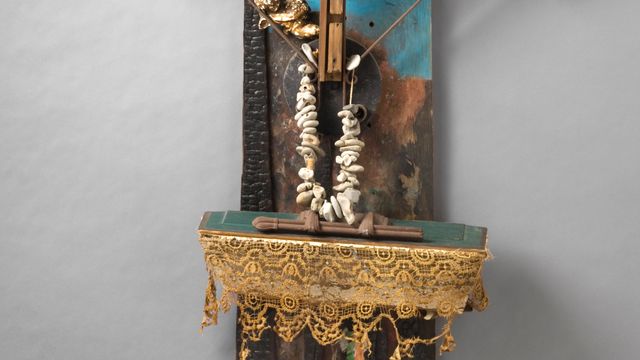
Gordon Wagner
Gordon Wagner was a pioneer of California assemblage, known for combining debris from the beaches and canyon cities of Southern California. He was a mentor to a variety of young assemblage artists, including George Herms.
Wagner was brought up in the carnival ambience of deteriorating beach cities, ports, and amusement parks. Orphaned at the age of twelve, he worked at arcades to help pay for his schooling, which eventually included degrees from Chouinard Art Institute and the University of California, Los Angeles. Like many assemblage artists, he had a penchant for science and, indeed, worked as an engineer-designer in the aerospace industry for twenty years. During this time he also lived, traveled, and studied in Arizona and Mexico, where his fascination with Native American mythology and legends and with the presentational forms of fetish and icon was to inform his early paintings and later assemblages. Yet it was the sideshow/peepshow atmosphere of the Southern California beach-city amusement park, with its blend of magic, nightmare, and fantasy, that was most influential in shaping his style.
As early as 1949 and 1950, at lesser-known galleries such as Willard Houghland and Graywood in Los Angeles, Wagner began exhibiting brightly colored, gestural paintings mounted on rough-hewn wood. Like much abstract expressionist work at the time, these paintings were concerned with myths of the collective unconscious. In the early 1950s he began using actual objects from the environment in his work; some of these assemblages were shown in 1956 at Ed Kienholz's Now Gallery, a precursor to the seminal Ferus Gallery.
In 1966 Wagner joined artists Noah Purifoy and Judson Powell as a participant in their exhibition 66 Signs of Neon, conceived as a collaborative project in the wake of the Watts rebellion of 1965. They gathered artist-friends, African American and others, who went out into the streets and picked up pieces of still-smoldering rubble to use in assemblages. According to Purifoy, "We wanted to tell people that if something goes up in flames it doesn't mean its life is over."# 66 Signs of Neon traveled to various California state universities as well as abroad.
In subsequent years Wagner moved from making free-form junk sculptures to placing found objects in cases under glass. After traveling in Europe, notably in Sweden, Holland, and Belgium, where his work was regularly shown, he began producing narrative box constructions using fabricated objects and painted backdrops in which odd juxtapositions and distortions recall the work of surrealist painter René Magritte. Wagner returned to junk sculpture in the mid-1980s, in his Whiskey Marine series.
—Naima J. Keith
Selected Commissions and Exhibitions
Solo exhibitions, Silvan Simone Gallery, Los Angeles, 1959, 1960, 1962, 1964.
27th Biennial, Corcoran Gallery of Art, Washington, D.C., 1961.
Snatches from the Underground, Bay Cities Jewish Community Center, Santa Monica, 1967.
66 Signs of Neon, Washington Gallery of Modern Art, Washington, D.C., 1969.
Assemblage and Collage, Los Angeles Institute of Contemporary Art, 1975.
Pacific Dreams: Currents of Surrealism and Fantasy in California Art, 1934–1957, Oakland Museum of California; Armand Hammer Museum of Art, UCLA; Nora Eccles Harrison Museum of Art, Logan, Utah, 1995.
Gordon Wagner and John Bernhardt, Tobey C. Moss Gallery, Los Angeles, 2000.
Selected Bibliography
"Gordon Wagner Pairs Technique, Subject." Los Angeles Times, April 3, 1967.
"In the Galleries." Los Angeles Times, February 20, 1955.
Miller, Arthur. "In the Galleries: Artist Picks Selectively from Nature’s Junk Pile." Los Angeles Times, June 29, 1962.
Wilson, William. "In the Galleries: Wagner Artistry Reflects Depth of Spanish Mystique." Los Angeles Times, April 30, 1965.
Wilson, William. "Western L.A." Los Angeles Times, March 14, 1975.
Selected Links
Gordon Walker biography page, Pacific Standard Time at the Getty Center, Los Angeles.
Richard Candida Smith, "Interview of Gordon Wagner," 1989, California Assemblage Art, Oral History Program, University of California, Los Angeles. Transcript, Charles E. Young Research Library, Department of Special Collections, UCLA.
Burt A. Folkart, "Gordon Wagner; Created Art from Junk," Los Angeles Times obituary, December 9, 1987.
"Gordon Wagner Papers Now on View," UCLA Library Special Collections Blog, February 7, 2013.


